|

2007 Wine News
 Latest Wine News Latest Wine News
December
17, 2007
Paris
Hilton is Prosecco's Golden Girl
We may
go to Wolfgang
Puck or Eric
Ripert for advice on food,
but when it comes to alcohol, is it safe to trust the expertise of
party girl Paris Hilton? Despite the 26-year-old heiress's 2006 conviction
of driving under the influence and subsequent time served in prison
for violating her parole,
she is nevertheless serving as spokeswoman for RICH Prosecco canned
sparkling wine. The
latest ad campaign features Hilton clad only in gold paint, crawling
across a desert, and is meant to reflect the eco-issue of global
warming, according to Prosecco.
Hilton told the Associated Press that she tries to do her own part
to save the earth, including little things like turning off lights
when she leaves a room, and, apparently, also by promoting her
own line of sparkling wine. She plans to donate 20 percent of the
proceeds from the RICH Prosecco to charities that provide clean
drinking water to areas in need.
December
10, 2007
Don't
Pair Polka with your Pinot
 |
The next time you sit down with a glass of Pinot
Noir, make sure to pay attention not only to how it tastes, but
also what music you’re listening to. Recent studies confirm that the music
playing and the taste of wine may be more closely related than
previously assumed. Winemaker and industry consultant, Clark Smith,
has taken the idea that sounds and music affect the taste of wine,
and taken it one step further. He has compiled many tasting panels
and had them sample 150 different wines while listening to a variety
of music styles in an attempt to determine which wines taste better
with which music.
Smith’s studies have focused on the actual
alteration of taste depending on the music. While his observations
and tasting panels strongly support certain pairings (red wines
are best enjoyed with music in minor keys or those songs with negative
emotions), there is limited scientific proof to back up these findings.
Smith plans to continue his observational research until he receives
grants to fund scientific studies. In the meantime, oenophiles
should not only look into which foods pair well with their wine
of choice, but also what’s in the CD player.
December
03, 2007
Full Glass, Happy Heart
 |
A
recent medical study has concluded that women who drink one or
two glasses of wine per day have less inflamed blood vessels,
resulting in healthier hearts. Chronic, low levels of inflammation,
which can be caused by smoking, high cholesterol and obesity,
are thought to contribute to the buildup of fatty deposits in
the inner lining of arteries. These deposits, called plaques,
can rupture and potentially cause heart attacks.
Led by Dr. Emilio
Sacanella, a team of researchers at the University of Barcelona
studied 35 healthy women, who all regularly drank wine. The
women involved in the study spent four weeks on a heart-healthy
diet, not drinking any wine. During the next four weeks, they
ate similar food, but had a glass of red wine with lunch and
dinner. The last leg of the study echoed the second, except the
women had white wine instead of red. Based on observations of
HDL (healthy) cholesterol and inflammatory substances in the
women’s blood, researchers
determined that the women had the highest HDL levels and lowest
levels of inflammatory substances during the red wine weeks. White
wine also had positive effects, but not as pronounced as those
of the red wine.
November
26, 2007
Location,
Location, Location
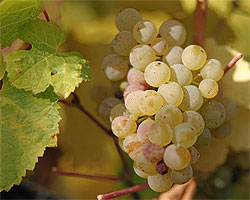 |
For
anyone who has ever wondered if it really matters where their wine
hails from, the proof is in. An agricultural research center in Germany has
determined that terroir, the attributes of vineyard land,
does affect the character and taste of wine. The three-year study
conducted by graduate student, Andrea Bauer, and research director,
Dr. Ulrich Fischer, focused on the Riesling varietal.
Growers from various regions were chosen for the study based mainly
on present soil types, with an emphasis on slate, basalt, limestone
and sandstone.
All grapes were vinified by Bauer and Fischer to ensure identical fermentation,
crushing and bottling procedures. The wines were then tasted in duplicate or
triplicate by expert panels trained to use sensory descriptors. From this data,
it was determined that wines produced on slate had sharper acidity and citrus
flavors; smoother acidity and rich fruit flavors resulted from basalt-grown grapes;
limestone produced wines with more intense color and aromas of tropical fruit
and honey; sandstone-grown grapes displayed aromas of citrus and minerals, with
an evident acidity. The research will continue with the 2007 vintage, taking
climate and topography into consideration.
Image from Wikimedia
Commons
November
19, 2007
A
New York State of Vine
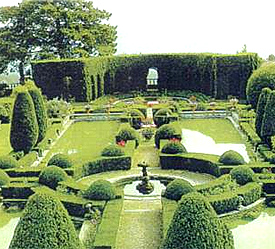 |
| The
Staten Island Botanical Garden will be the site of
a Tuscan-style vineyard and garden. |
New
York City currently boasts many hot
spots to grab a glass of wine, but early next year, the
city will start producing grapes to actually make its own wine.
The Tuscan Gardens Vineyard Founders Group is working with
the Staten Island Botanical Garden to develop a two-acre vineyard
and winery, modeled after current wine producers in Italy.
In the spring of 2008, the vineyard will begin to take shape,
accompanied by Tuscan Garden exhibitions based on the Villa
Gamberaia, near Florence.
Members of the Founders Group traveled to Tuscany to observe the city’s
vineyards and learn from Italian winemakers, including Piergiorgio Castellani,
who is attempting to protect grape varieties indigenous to certain regions of
Tuscany from becoming extinct. Castellani’s interest in varietals with
history ties in with the goals of the Founders Group; they plan to integrate
heritage grape varieties that grew in colonial times. Viticulture and enology
experts from Cornell University have also been called in to help determine which
types of Italian grapes have the best shot of flourishing on Staten Island.
Image from Staten
Island Botanical Garden
November
12, 2007
Rosenthal
Wines Celebrate 20 Years in Malibu
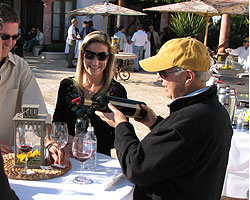 |
In
the idyllic setting that is The
Malibu Estate, on a glorious November day, George Rosenthal
hosted a VIP party with his wine club members to celebrate
20 years in what is now the Malibu-Newton Canyon AVA. “In
the late 1800s, more wine was exported from Southern California
than any other wine region,” George said. “We are
pleased to have you today celebrating not only our 20th anniversary
but also the return of winemaking in the area.” For about
three years now, it has been possible to run a bonded winery
in Los Angeles County, and a few operations have set up shop.
The wines here are made under the watchful eye of master winemaker Christian
Roguenant. He is originally from Dijon, and he has worked with Baileyana, Tangent, Carpe
Diem and Maison Deutz, all in the Santa Ynez Valley. He conveyed news about
vineyard development, like the addition of a two-acre parcel dedicated to the
tricky Viognier varietal. “More
and more of the winery operations are being transferred here,” explained
longtime Marketing and Sales Director Neil McNally. “We want the crushing
facility to come to Malibu, and we are planning caves as well.” Attendees
sampled the 2005 Chardonnay, a soon-to-be-released 2004 Cabernet Sauvignon and
an unexpected 1992 Cab en magnum (the winery’s third release), and enjoyed
live music by Coffey and Kevin Misajon and grub by barbecue master Dan
Cannon. For additional information and wine club events, contact Leigh Metzger
at 310-899-8900 x242 or visit www.rosenthalestatewines.com.
November
5, 2007
New
Device Detects Headache-Causing Amines in Red Wine
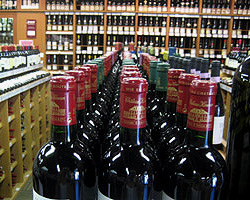 |
The
cure for hangovers may still be in the distant future,
but chemists have created a way to avoid the headaches
that can result from imbibing red wine. Researchers at
the University of California, Berkeley, have developed
a detector the size of a small briefcase that tests liquids
for presence and levels of the chemicals, called biogenic
amines, which cause the dreaded “red wine” headaches.
The device needs only a drop of wine and five minutes to
determine amine levels.
Richard Mathies, who was involved in the development of the
detector, has co-founded a company that plans to produce
a smaller device to make testing in public places more practical.
Although the headaches are most commonly associated with
red wine, these amines are also found in other food products
that are aged, pickled and fermented, including chocolate,
cheese, olives, nuts and cured meat. Right now, there is
no way to prevent the pains, but this device may help those
who are prone to headaches avoid wines with high amine levels,
or at least warn them that they may soon be in need of extra-strength
pain relievers.
October
29, 2007
Harvest
Gives Champagne a Reason to Celebrate
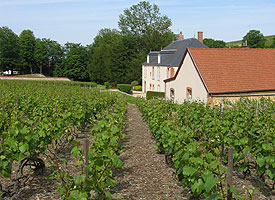 |
The
nearly 81,000 acres of productive vineyards in Champagne, France,
have set new records with their 2007 harvest. This year’s
grapes have the potential to produce more than 389 million
bottles of wine, topping 2004’s record of 375 million
bottles. The average yield per vineyard was 14,000 kg/hectare
(about 12,500 lbs/acre), nearly reaching the maximum yields
of 15,500 kg/hectare (about 13,800 lbs/acre) set by the Institut
Nationale d’Appellations d’Origine (INAO).
This year also marks a change in maximum yields allowed by the INAO, which is
similar to the AVA system in the United States. The new maximum will be in place
for a five-harvest experimental period from 2007 to 2011. If it hadn’t
been for uncooperative weather, vintners project that they could have produced
even more grapes, possibly reaching the new limit. A difficult summer affected Pinot
Noir and Pinot Meunier grapes, and other parts of the region were hit with
hail, resulting in areas with yields as low as 8,000 kg/hectare (about 7,100
lbs/acre). Despite
weather difficulties, Champagne producers are sure to rake in large profits,
giving them plenty of cause to pop open some bubbly of
their own.
October
22, 2007
Cleavage
Creek Proceeds Benefit Breast Cancer Research
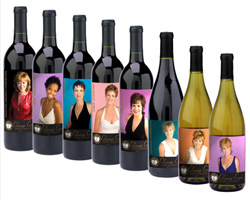 |
Don't
be fooled by the name of Budge Brown's new winery, Cleavage
Creek Cellars. He's not being exploitative, but rather charitable.
After losing his wife of 48 years to breast cancer, Brown hopes
his wines will stop others from having to experience similar
losses. Ten percent of gross sales of his wines will support
breast cancer treatment and research to find a cure. He has
already donated $5,000 to the Breast Cancer Care Center of
Sutter Medical Center of Santa Rosa to assist in the purchase
of an MRI machine used to assess the severity of breast cancer.
The seven women featured on the eight varietals of Cleavage Creek’s first
offering support Brown’s cause, as each is a survivor of the disease. Brown’s
winery has produced about 2,000 cases, consisting of a 2005 Reserve Napa Cabernet
Sauvignon, 2005 Reserve Napa Petite Sirah, 2005 Cabernet-Syrah, 2004 Merlot,
2004 Merlot-Syrah, and 2006 Reserve Chardonnay. Also available are the 2003 Secret
Red and 2006 Secret White. Prices range from $18 to $50. For more information
or to purchase the wines, visit the winery’s web site, www.cleavagecreek.com.
October
15, 2007
Hello
Merlot, Goodbye E. coli
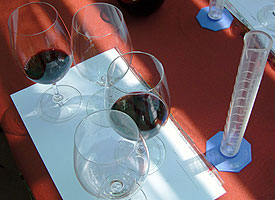 |
Researchers
have given oenophiles yet another green light to enjoy red
wine. In addition to the ever-growing list of health benefits,
studies conducted at the University of Missouri-Columbia have
concluded that the vino also protects humans from foodborne
pathogens such as E. coli, Salmonella and Listeria.
Associate professor of food science Azlin Mustapha and food science doctoral
student Atreyee Das found that the protection is due to the combination of ethanol,
pH levels and resveratrol,
a phytochemical found in the skin of grapes. These ingredients also fight Heliocobacter
pylori bacteria, the main cause of stomach ulcers. The anti-microbial properties
of the grapes counter dangerous pathogens without harming useful bacteria in
the body. Those who prefer Pinot
Grigio to Pinot
Noir will be disappointed that the beneficial findings of Mustapha and Das
do not carry over to the lighter-hued varietals. However, the pathogen fighters
are present in red grape juice, so parents who don't wish to fill their children's
sippy-cups with Merlot are
in luck.
October
10, 2007
Rosé
Now Blooms Outside the Vineyard
Domaine
Carneros has recently opened the garden gates, allowing their
Brut Rosé to bloom outside the vineyard. Originally,
winemaker Eileen Crane's bubbly blend of Pinot Noir and Chardonnay
was only available at the winery, but a growing demand for
sparkling Rosé and increased interest from consumers
has led to its debut in major U.S. markets for $30 a bottle.
The Brut Rosé can be enjoyed on its own, or in the Domaine
Carneros signature cocktail, “Bouquet of Rosé," developed
by "The
Liquid Muse,"
Natalie Bovis-Nelsen, in honor of the sparkling wine's national
release.
Bouquet
of Rosé
1/2 oz. Sence Rose Nectar
3 1/2 oz. Domaine Carneros Brut Rosé
Dash of rose water
Sprig of fresh lavender
Pour
rose nectar and Domain Carneros Brut Rosé into
a chilled champagne bowl. Add a dash of rose
water. As an aromatic garnish, lay a sprig of
fresh lavender across the top of the glass. |
|
October
1, 2007
Better
Grab a Cleveland Claret
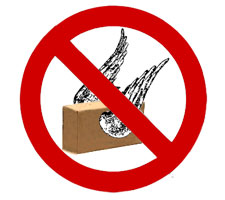 |
Wine-loving
Ohio residents will now find it much more difficult to acquire
a bottle of their favorite out-of-state red or white. Beginning
this month, legislators have prohibited direct-to-consumer
shipments from wineries not based in Ohio whose total production
exceeds 62,500 cases. Many organizations, such as the national
consumer grassroots coalition freethegrapes.org, have been
protesting the law since it was passed by the state legislature
as part of a budget bill.
For smaller wineries, the law also sets an annual 24-case limit “per family
household,” versus the “per winery, per individual” standard
used in many states. Therefore, the wineries that are still permitted to ship
to Ohio will likely opt out in order to protect themselves from potential non-compliance
charges. While some out-of-state wines may still be available in the Buckeye
State for slightly elevated prices, many wineries and vineyards do not distribute
nationwide. The best bet for Ohioan oenophiles seems to be relocation, as direct-to-consumer
wine shipments are legal in 34 other states.
September
24, 2007
Australian
Wine Production Takes a Dive Due to Drought
 |
Due
to severe drought in Australia,
many vineyards and wineries down under may be going under.
During an average year, the Aussies harvest about 1.9 million
tonnes (about 2 million tons) of grapes for winemaking. The
predicted vintage for 2008 will be significantly smaller, yielding
somewhere between 800,000 tonnes (about 880,000 tons) and 1.3
million tonnes (about 1.4 million tons). Vintners who rely
on the Murray-Darling Basin for their irrigation water have
been hit hardest by the drought, namely those located in Victoria’s
Murray Valley and South Australia’s Riverland regions.
The Murray-Darling Basin is responsible for nearly half of Australia’s
agricultural goods. Government aid packages have done little to remedy effects
of the country’s continuingly dry conditions. Nearly a thousand wine grape
growers are in danger of going out of business. Also in question are the long-term
effects the water shortage will have on Australia’s wine industry, which
brings in billions of dollars each year. Prime Minister John Howard announced
the drought has the potential to kill many of the region’s orchards and
vineyards, and declared the situation “a genuine crisis.” Howard
has encouraged Australians to pray for rain so they can turn their water into
wine.
September
17, 2007
Martha
Stewart Adds Wine to her List of Business Ventures
 |
Just
when you thought she couldn’t possibly branch out into
another aspect of domestic life, Martha Stewart has announced
she will be serving up her own wine. Stewart and E. & J.
Gallo, with whom she has had a long-standing business relationship,
will produce the “Martha Stewart Vintage” line.
Three wines will make up the initial 15,000-case offering:
2006 Sonoma County Chardonnay, 2005 Sonoma County Cabernet
Sauvignon and 2006 Sonoma County Merlot. The wines, which are
slated to go on sale in early 2008, will not immediately be
available nationwide. At the launch of the project, they will
only be sold in Atlanta, Boston, Charlotte, Denver, Phoenix,
and Portland, OR. Each bottle will cost about $15. Stewart,
known for her homemaking ways and her brief stint in the big
house, has vastly expanded her Martha Stewart Living empire
in the past year. Her business ventures range from crafting
supplies to branded homes, and most things in between.
September
10, 2007
Pop
the Bubbly: September 2007 is “California Wine
Month”
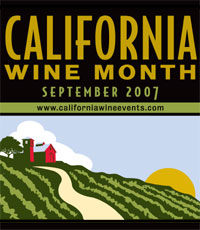 |
Governor
Arnold Schwarzenegger has given Californian oenophiles another
excuse to drink wine during the month of September, officially
declaring it “California Wine Month.” Throughout
the state, wineries are offering special tours, and tasting
rooms are featuring deals on their products. Some of the state's
2,000-plus wineries are
even branching out from the traditional tours and tastings
and hosting events like the Wine Country Music Awards, which
will be held at the Silver Horse Winery in San Miguel. With
nearly 100 winegrape varieties grown in California,
there’s something for everyone, regardless of whether
you indulge in Sauvignon
Blanc or cross over to the dark(er) side with a Pinot
Noir. Retailers like Vons and Safeway are getting in on
the fun, prominently displaying California wines. If you don’t
call the Golden State home, no need to fret; restaurants and
retailers from coast to coast will also be featuring wines
produced in California. For a full list of events and more
information about California wine, visit www.californiawineevents.com.
September
3, 2007
Mutant
Grapes Aim to Make the World a Better Place
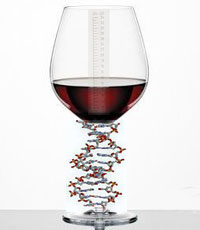 |
Scientists
hard at work in laboratories in France and Italy can
finally sit back and enjoy a glass of what they’ve
been studying. Thirteen genes that give Pinot
Noir grapes and the wine they produce their distinct
flavors have been identified. These findings may mean new
breeds of the grapes that can resist disease. Grape DNA
can also be controlled to produce specific changes in flavor.
In the study, the genes that make molecules called tannins
and terpenes, which control the flavor and aroma of the
grapes, were amplified and identified. Vintners who dabble
in science or vice versa may be able to use this information
to spotlight certain flavors and eliminate others. Beyond
taste adjustments, these findings help promote the health
of the crops. Each year, wine producers face the possibility
of their harvest being affected by mildew, fungus and disease.
Both France and Italy count wine as highly important to
their economies, so this discovery may result in not only
tastier wines, but higher GNPs.
August
27, 2007
J's
Luxurious Essence Tasting Tantalizes Tastebuds
 |
J
Vineyards & Winery is taking the guesswork out of food
and wine pairing, and they’re doing it with style.
The Healdsburg, California,
wine producer now offers a dining experience designed to stimulate
the senses. The Essence
Tasting is offered only once a week, each Thursday from
11 a.m. - 3 p.m. Before guests are seated and served, they
get to see where their wine is coming from and learn a bit
about one of J’s eight vineyards. It’s not all
business though – while they learn about the Russian
River Valley, they get to sip a glass of Nicole’s Vineyard Pinot
Noir. They are then served a seven-course tasting menu
prepared by executive chef Mark E. Caldwell. Each course is
paired with a wine produced by J. The elaborate meal begins
with an Amuse of Kumamoto Oyster and Osetra Caviar, paired
with J’s Vintage Brut. For the main course, Porcini Mushroom
Crusted Noisette of Lamb is served with J’s Pinot Noir.
The cost is $200 per person and reservations must be made at
least two weeks in advance. More information about J Vineyards & Winery
can be found at www.jwine.com.
August
20, 2007
Spoiled
Spoils of War Fetch Thousands
A
1937 bottle of Moët & Chandon champagne, although
rare, is valued at about $200. So why did one particular bottle
sell for nearly $3,000 when it possibly has been poisoned?
The 70-year-old bottle is believed to have once belonged to
Adolf Hitler.
After
Germany’s defeat, Hitler’s wine cellar in the Reich
Chancellery in Berlin was raided, and one of his bottles of
champagne was obtained by a British soldier. The man he gave
it to recently had it put up for sale by Charterhouse Auctioneers
in Sherborne, Dorset, England. Two Swedes purchased
the artifact for £1,450 (about $2,880) to use in a television
program they are making on dictators. They say they may resell
the bottle and donate the proceeds to a Jewish charity. Beyond
being well past its prime, the champagne should not be imbibed
because of uncertainty about whether it was injected with cyanide
by Nazis during the war. Hitler never used the bottle to toast
any of his victories, as he did not drink alcohol.
August
13, 2007
Cork
Producers Say, "Keep it Real!"
 |
With
an increase in the use of synthetic corks, environmentalists
and cork manufacturers are encouraging wine producers to
act natural. The decrease in demand for natural cork makes
environmentalists worried about the survival of animals
like the endangered Iberian lynx and the Barbary deer,
which frolic in cork forests. In order for cork to stay
off the endangered species list, producers have to ship
more out, and an eighteen percent jump in the use of synthetic
wine-stoppers in the past seven years makes cork's future
look darker than a glass of merlot. Wine industry consultants
expect the synthetic trend to continue, predicting an additional
fifteen percent increase in the use of cork alternatives
by the end of the decade. Cork producers and environmentalists
are looking to chop down the synthetic trend with the help
of the Forest Stewardship Council's "environmentally
friendly" stamp, hoping that "green" shoppers
will seek the eco-friendly stoppers and keep the industry
afloat. So in this curious case, environmentalists are
asking us to use more of a natural resource, not less.
August
06, 2007
Napa
Legend Sold
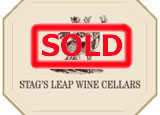 |
Warren
Winiarski’s Stag’s Leap Wine Cellars, held
privately for 35 years, sold in late July to Washington-based
Ste. Michelle Wine Estates and Italy’s Marchese Piero
Antinori for $185 million. 79-year-old Winiarski, whose
1973 Cabernet
Sauvignon famously beat out some of France’s
stiffest competition in the Judgement of Paris Tasting,
decided to put his business on the market after family
issues regarding continued ownership of the winery couldn’t
be ironed out. The sale is keeping with current trends
in Napa Valley, where many major wineries are being bought
up by larger corporations. Between the allure of
hefty buying prices (roughly $275,000 an acre) and the
challenges that come with passing a family business on
to the next generation, many of Napa’s most famous
properties are being snatched up by larger corporations.
Big names like Robert
Mondavi and Beringer, both sold in the past three years
to Constellation Brands and Fosters Group of Australia
(respectively), are a prime investment for companies looking
to put their money in a winery that the public already
knows and loves.
July
30, 2007
Rowdy
Oenophiles Get Carded
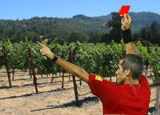 |
Not
only will some winery visitors be carded on the way in,
but also on the way out. Wineries in the Finger Lakes region
of New
York have developed a new system, debuting this summer,
that puts obnoxious imbibers in the proverbial naughty
chair. While some winery owners believe that personal responsibility
is enough to keep customers in line, others (namely those
who have experienced topless vineyard runs, public urination
and swimming races in decorative fountains) disagree. If
an individual has sampled a few too many Chardonnays and
begins engaging in obnoxious (or illegal) behavior, participating
wineries can issue the offender one of two cards. As
in soccer, the first card is yellow, which serves as a
warning that further inappropriate behavior will not be
tolerated. If the drunken antics continue, they are
then given a red card, which signals the end of their winery
tour. In addition, other wineries that the transgressor
was scheduled to visit later in the day will be called
and informed of the ban.
July
19, 2007
The
Dom Perignon Vintage 1999 is Out
Its
reputation precedes itself, but in the case of the 1999
we want to say simply: WOW! Now allow us to elaborate somewhat
on this glorious event. We had the chance to sample a few
glasses of the golden bubbly with the man who made the
stuff, Chef de Cave extraordinaire Richard Geoffroy, and
Dom Pierre Perignon himself would be proud. The Champagne
was accompanied by the succulent
food of the house chef, Pascal Tingaud. We found the
wine to be extremely approachable and round. Young, certainly,
but with an ability to age, an extreme versatility with
food and good from the get-go. It has also mastered the
primary task of what defines a prestige
cuvee Champagne: complexity. In Richard’s words: “How
can it be so complex, so subtle, yet mature? That’s
the wonderful paradox of Dom Perignon Vintage 1999.” Please
rush out to your fine local
wine retailer and grab a few bottles, you will not
be disappointed.
July
16, 2007
Brush,
Floss, Swirl and Sip
Researchers
from the University of Pavia in Italy have discovered a
surprising new health benefit that comes from sipping vino:
cavity prevention. The researchers began their study
by taking samples of both red and white wines and removing
the alcohol, which contains result-muddling ethanol and
is also known for being naturally antiseptic. They then
introduced strains of streptococcal bacteria, the culprit
behind your cavities, to the alcohol-free vino. Results
showed that both red and white wine fought off the troublesome
substance, and it also kept related strains of streptococcal
bacteria (namely, the kind that causes sore throats) at
bay. While red wine was found to be slightly more effective
at keeping teeth healthy and happy due to a higher quantity
of acid, sipping either color may help to keep dental bills
down. So, the next time you waffle over buying an
expensive bottle of wine, just think of it as an investment
in your oral health.
July
9, 2007
A
Rat in the Cellar
Fans
of Disney’s
newest film Ratatouille,
the story of a French rat with great culinary aspirations,
can now bring home an unusual piece of Remy the Rat memorabilia:
a fine Chardonnay. The wine is part of the uber-company’s
new, sophisticated marketing initiative that leaves the
cloying cutesiness of character-branded merchandise behind
in favor of a more adult spin. In addition to the vino,
offerings include princess-inspired bridal gowns and a
line of retro furniture inspired by Walt’s personal
collection. Set to debut in early August at Costco stores,
the wine is made in the legendary Burgundy region, and,
appropriately, pairs well with the famous French dish for
which the movie is named. At only $13 a bottle, Ratatouille
Chardonnay isn’t much more than a pair of mouse ears.
Thanks to Disney, having a rat in the cellar doesn’t
seem so bad.
July
2, 2007
Red,
White and Blues Brother
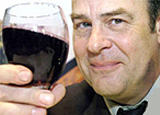 |
He's
sported a conehead, busted ghosts and played a wailing
harmonica as Elwood Blues. Now Canadian comedian
Dan Aykroyd can add another role to his resume: winemaker.
Following on the heels of his generous investment in the Niagara wine
region of Canada, Aykroyd has created an eponymous line
of wines that were released in that country this June. In
addition to the moderately-priced Dan Aykroyd Discovery
Series, ranging from $15 to $25, he also is debuting the
high-end Dan Aykroyd Signature Reserve Series, which will
be priced at around $50 per bottle. The Academy Award nominee
has also announced plans to open The Dan Aykroyd Winery,
a joint venture with Diamond Estates Wine & Spirits,
which should be up and running in time for the 2008 growing
season. The Beamsville Bench winery will be entirely green,
utilizing solar panels and environmental water management
systems, and will also showcase some of Aykroyd's movie
memorabilia. Sadly, non-Canadians looking to get their
hands on the actor's wine will have to wait. Stateside
distribution is slated to begin in February 2008, when
the vino will arrive in stores and be served up at House
of Blues venues across the country.
June
25, 2007
Join
the K'orus
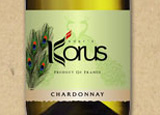 |
Kedar
Beverages plans to bring wine to an untapped market this
summer with K’orus wine, geared primarily towards
the African-American consumer. Created by Kedar Massenburg,
former CEO of Motown Records, and noted oenologist Jean-Sébastien
Robicquet, K’orus is a French wine that steers clear
of the pretentious vibe that often comes along with the
production and consumption of fine wine. The label is introducing
a Merlot, Chardonnay and Cabernet Sauvignon for wine novices
which will all retail for less than $15 a bottle. They
are geared towards the African American market, which currently
represents only 10% of wine imbibers. Four more varietals
of the budget-friendly wine, including Champagne, are expected
to be introduced in the next year. A series of launch events
and an extensive advertising campaign are set to introduce
Americans to this new wine brand, like its debut fête
at Mr.
Chow in Beverly Hills, where K’orus is currently
the house wine. Celebrities like Stevie Wonder and Vivica
A. Fox were on hand to sip their support and toast to K’orus’ success.
June
18, 2007
Work
of Art
Hyatt
Hotels & Resorts launched its new signature wine brand,
dubbed “Canvas,” which will be served at all
Hyatt restaurants and bars in the United States, in early
June. Developed with the help of Folio Fine Wine
Partners, the Napa Valley-based company of Michael Mondavi
and family, the wine is designed to represent “the
art of living.” After collaborating with Master
Sommelier Andrea Robinson Immer, Mondavi created three
varietals for the hotel: a 2004 Cabernet Sauvignon with
lush aromas of black cherry, blackberry and cassis, a 2005
Chardonnay that features notes of apple blossom and honeysuckle
and a 2005 Merlot with rich tannins and subtle flavors
of spice. Hyatt unveiled its new liquid asset at the Grand
Hyatt New York, where guests sampled Canvas selections
while browsing original artwork on loan from the New York
Academy of Art. More tasting events are expected to follow
at Hyatt locations across the country.
June
11, 2007
Napa
Auction Opens Hearts and Wallets
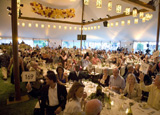 |
The
Napa Valley Vintners’ annual Auction Napa Valley
concluded on June 10 after raising over $9.8 million for
charity over the course of their four-day celebration.
Highlights of the event, dubbed “The American Classic,” included
the sale of 106 barrel lots, a summer soirée under
the stars with hors d’oeuvres prepared by the Food
Network’s Michael Chiarello, and Dana Carvey’s
stand-up act, during which he lampooned Speaker of the
House and Napa Valley vineyard owner Nancy Pelosi (not
realizing that her husband was only a few seats away).
Lucky bidders returned home with loot like limited-production
wines, a pre-release Lexus luxury
hybrid sedan loaded with vino, and a luxurious Italian
getaway. Throughout the weekend, attendees doled out
their dough to support health care, youth services and
affordable non-profit housing, but the most heartfelt giving
of the weekend occurred during the first ever “fund
a need” auction. Led by John Shafer of Shafer
Vineyards, 68 bidders volunteered over $764,000 to support
children’s health care at Clinic Ole, with no other
prize in sight.
Image
courtesy of Napa
Valley Vintners
June
5, 2007
California
Wine Sales Set Record
California
wine sales have reached a record high with sales in 2006
reaching a staggering total of 449 million gallons. The
recent growth trend is thought to be a result of the media’s
increased coverage of the health benefits of the resveratrol and
antioxidants found in wine, as well as an increase in California
wine country tourism. U.S. exports have grown
30 percent in value and four percent in volume, with 95
percent of that wine coming from California vineyards.
As appreciating wine becomes a pastime for the masses and
not just the snobby elite, consumers are buying more premium
wine than ever before, with purchases of bottles priced
at $15 or more on the rise. As American wine culture continues
to gain popularity, sales are expected to continue growing
as they have for the past thirteen years. There are now
more than 5,000 American brands currently on the market.
May
29, 2007
AVA
Debate Continues
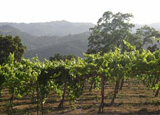 |
Wineries
in Paso Robles seem to be having a hard time seeing eye
to eye these days. Currently the largest undivided
AVA in California at 667,000 acres, Paso
Robles is currently at the center of a heated debate
regarding the creation of subappellations that would more
accurately reflect the distinct and unique winegrowing
areas within the larger region. Two conflicting proposals
are on the table, with the Alcohol and Tobacco Tax and
Trade Bureau (TTB) pushing to split Paso Robles into East
and West, and another plan (promoted by the Paso Robles
AVA Committee) which proposes dividing the area into
11 separate subappellations. Supporters of the Paso Robles
AVA Committee, including Justin
Winery owner and committee vice-chairman Justin Baldwin,
believe that simply dividing the area into East and West
doesn’t accurately represent the different climates
and conditions of the wine growing area, and those who
oppose the committee claim that the boundaries currently
set for the 11 separate AVAs are random and nonsensical.
It’s unlikely that a universally accepted solution
will be found anytime soon, but the TTB is closely monitoring
the debate and hopes to resolve the issue as quickly as
possible.
Image
courtesy of Justin
Winery
May
21, 2007
From
Barrel to Biofuel
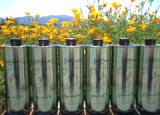 |
Entrepreneurs
Nanette and Valentin Humer really know the meaning of the
phrase “one man’s trash is another man’s
treasure.” The duo has made their living by collecting
the waste left behind after a vineyard’s grape crush – specifically,
the seeds- to create Salute Santé, a light-tasting
grape seed oil for cooking. A staple at Napa Valley
restaurants like Julia’s
Kitchen, Silverado
Resort and Zuzu,
Salute Santé is a light alternative to other cooking
oil, and features a clean taste and high smoke point. Now
they’re taking their love of wine waste one step
further, and using discarded grape seed oil to fuel their
vehicles. While most restaurants typically pay to have
used oil carted off, Salute Santé users have their
used oil picked up free of charge by the Humers, who then
pour it into the tanks of their two Mercedes
Benz vehicles and Ford truck. Converting an engine
from diesel to grape seed oil isn’t a cheap process;
it typically costs around $2,000, but the Humers haven’t
seen a gas station in years. The couple hopes that
other oenophiles will be inspired by their environmentally
friendly philosophy, and find ways to “close the
loop” in their own lives.
May
14, 2007
Pest
Warfare
 |
The
light brown apple moth, a pest known for plaguing the vineyards
of New Zealand and Australia, has recently made its unwelcome
debut in California. The California Department of Food
And Agriculture has confirmed its presence in more than
eight counties, including Marin, Monterey, San Francisco
and Santa Cruz. Australian viticulturists report that moth
generally causes between 15-30% crop loss per season. While
winemakers are understandably distressed by this information,
the critters have only been spotted crawling on nursery
stock, meaning that there may still be time to take preventative
measures. CDFA officials are employing a highly effective
pheromone trap to help them gauge the extent of the infestation
and plan for extermination. If the moths are discovered
in the larval stage, a simple organic spray can contain
the problem. If the growth progresses to the caterpillar
stage, however, especially when they hide in grape bunches
(out of sprays’ reach), they can be particularly
hard to control.
Image
courtesy of CDFA
May
07, 2007
James
Beard Winners
The
James Beard Foundation announced the winners of their prestigious
awards for excellence in the culinary world on May 7th
in New York's Avery Fisher Hall at Lincoln Center. In addition
to honoring the accomplishments of their own, the foundation
also raises funds to provide scholarships to future culinary
professionals and educates parents and children across
the country about food and nutrition. This year, honorees
included two exceptional wine authorities. Outstanding
Wine and Spirits Professional went to Paul Draper of Ridge
Vineyards in Cupertino, California. Mark Slater—pictured
at left wearing his prestigious accolade—of Michel
Richard Citronelle in The
Latham Hotel in Washington, D.C. took home the Outstanding
Wine Service Award. Click here for
more award winners.
April
30, 2007
Stiff
Drink
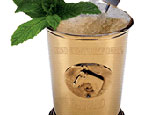 |
From
the opulent outfits to the pricey ponies, it’s safe
to say that Kentucky Derby fans are comfortable with the
concept of luxury living. Woodford Reserve, the Official
Bourbon of the Kentucky Derby, is now giving indulgent
race-goers the opportunity to enjoy a luxe libation on
race day: the $1,000 Mint Julep. Only fifty of the costly
cocktails will be mixed, with proceeds to benefit Green
Pastures, a non-profit organization that supports disabled
jockeys and retired thoroughbreds. Made with mint from
Morocco, ice from the Bavarian Alps, sugar from Australia
and a special batch of Woodford Reserve, the mint juleps
are served up in cups created by New England Sterling,
the same company that manufactures the winner’s trophy. This
year’s cups, some of which are being auctioned off
by Christie’s, are plated in 24-kt gold and feature
profiles of the Derby’s previous winners, such as
Barbaro and Aristides. Sipping becomes an elegant affair
with the included sterling silver straw.
April
23, 2007
High-Tech
Protection
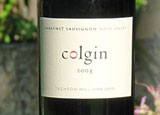 |
Ann
Colgin, owner of Colgin Cellars, has recently taken steps
to protect her pricy wines with a new, high-tech, anti-counterfeit
system. With vintages selling for more than $800
a bottle and approximately 3,000 customers clamoring to
make it on their exclusive mailing list, the winery wants
to make sure its buyers are getting the high-quality wine
they pay for. The new protection system known as “Traceless,” originally
developed by Kodak to prevent fraudulent pharmaceutical
sales, is shrouded in secrecy. Very few details are available
to the public about the system, and Colgin has declined
to comment on the process, citing an anti-disclosure agreement.
What we do know is that a colorless, odorless, invisible
marker, adhesive to virtually any material and only detected
by a Kodak scanner, is applied to a surface, such as a
wine label or synthetic cork. The limited-availability
scanners are temporarily leased to those who have passed
a stringent background check and can prove a verifiable
need to use them, and are then promptly returned to Kodak’s
possession. Other wineries are expected to follow suit
in the near future, allowing wine collectors to pursue
their passion without having to fret that the vintage Bordeaux
they bought is actually just re-packaged Charles Shaw.
April
16, 2007
Wearable
Wine
 |
Who
among us hasn’t accidentally worn their wine after
a stain-producing spill? Australian Gary Cass has actually
developed a way to wear wine on purpose. The University
of Western Australia at Perth scientist’s new line,
aptly named Micro’be’, is made from the cellulose
woven by bacteria in vats of fermenting wine. The
rubbery, slimy cellulose that develops on the surface is
skimmed from the top of wine vats and then draped across
the line’s first model – a life-sized blow-up
doll. The cellulose shrinks to fit the form, and once the
desired shape is achieved, the blow up doll is deflated
and removed. Cass doesn’t expect to see his highly
impractical designs on the racks anytime soon, but hopes
that they will spark debate about the future of organic
fashion. The biggest problem with bacterial haute couture
is that it must be kept wet, as the fibers aren’t
long enough to move with the body and tend to break when
dry. Perhaps you can increase their utility by spilling
your wine on them!
April
9, 2007
U.S.
Wine Exports on the Upswing
Recent
Department of Commerce data indicates that last year’s
wine exports increased by thirty percent in value and four
percent in volume, following the disappointing market drop
in 2005. More than half of the exports end up in Europe,
where U.S. wine value increased by 48 percent in 2006.
It’s no surprise that the majority of the exports
come from California, a trend that should continue following
the recent agreement guaranteeing that the European Union
market will remain open to the Golden State while maintaining
consistent trade requirements. Some factors that may have
contributed to the rise in international sales are the
recent trend of shipping wines to Europe for bottling and
distribution (avoiding hefty shipping costs) and the implementation
of special labels designed to attract more European customers.
April
2, 2007
Virtual
Vineyard
Wine
lovers who have fantasized about owning and operating their
own vineyard are one step closer to their dream thanks
to Crushpad, the brainchild of San Francisco businessman
Michael Brill. The web-based interactive winery allows
users from any part of the world to design and bottle their
own wine, with participation varying from a few mouse clicks
to physically de-stemming and crushing the grapes from
their chosen vineyard. Users who can’t travel to
Crushpad’s San Francisco facility receive frequent
e-mail updates and can oversee the crush of their grapes
via webcam complete with live chat, so that the at-home
vintner and employees can communicate. Users then perfect
the blend and design their wine’s packaging, and
some go on to participate in interactive tasting sessions
with other users. Membership starts at $5,000 and includes
all the costs of your wine, with a minimum production of
one barrel a year. For more information, visit www.crushpadwine.com.
March
26, 2007
Utah
Puts the Brakes on Merlot Plate
Wine
lover Glenn Eurick was recently informed by the Utah Tax
Commission that the vanity plates on his dark red Mercedes
are unacceptable and must be removed. The offensive slogan?
MERLOT. Utah forbids the use of words or phrases related
to intoxicants on its vanity plates, a policy that it enforces
by way of a strict screening process that occurs before
the plates are issued. Eurick’s plates had been mounted
on his car for over ten years before an anonymous tipster
called the government to report that Merlot was
an alcoholic beverage. Claiming that his plates reference
the color of his vehicle, Eurick plans to challenge the
state’s decision. If the mandate stands, he wants
his next set of plates to read “NO MERLO”.
March
19, 2007
Friendlier
Skies for Sonoma Travelers
It’s easy to enjoy the wines
of Sonoma
Valley when you’re vacationing there. Bringing
them home for future enjoyment, however, is no easy task;
shipping is troublesome and costly, and the TSA liquid and
gel ban has made bringing purchases on the plane impossible. Luckily,
Horizon Air has instituted a new policy that allows jet-set
oenophiles to check one case of wine (containing up to 12
bottles) as a third bag on flights departing Santa Rosa free
of charge. The pro-wine program was developed in conjunction
with the Sonoma County wine community to celebrate Horizon’s
new Santa Rosa route. Passengers of legal drinking age on
the vino-friendly flights will also enjoy free samples of
local wines and microbrews.
March
12, 2007
Historical
Hoax
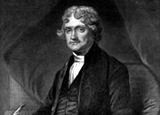 |
Avid
wine collector William Koch, whose cellar holds over 35,000
bottles, has filed a lawsuit alleging that he was sold
counterfeit vintage wine. Four of the bottles in
question, for which the Florida-based mining and energy
firm president paid roughly $100,000 apiece, were said
to be from Thomas Jefferson’s personal collection,
found entombed behind the wall of a Paris cellar. The
possible fraud may have gone undiscovered had Koch not
been asked to display his acquisitions in The Museum of
Fine Art in Boston where experts turned a wary eye on the
potentially doctored bottles. A closer examination revealed
that the former president’s initials, etched into
the glass, were carved not by hand, but by a modern power
tool. In addition to the suspiciously modern handiwork,
Jefferson experts from his Virginia home report that there
is no historical evidence to suggest that Jefferson monogrammed
his bottles. German wine merchant Hardy Rodenstock, accused
by Koch of committing the forgeries and then reselling
the bottles to wine dealers, admits to no wrongdoing and
claims that whoever drinks the “absolutely genuine” wine
will be “drinking history.” The FBI is currently
investigating the case.
March
5, 2007
Global
Warming May Change Wine Map
A recent study by Florence University
in Florence,
Italy has revealed that the rising temperatures and heavy
rains caused by global warming may adversely affect the quality
of grapes produced by Italy and other top wine production
areas. If global warming continues unchecked, overall
temperatures are expected to increase by eleven degrees in
the next hundred years. Since grapes would over-ripen
in these conditions, the ideal areas for vineyards would
shift north, changing what we now consider the world’s
foremost wine regions. A similar trend has been observed
by olive farmers, whose crops have begun thriving further
and further north, almost reaching the Alps. While most winemakers
are not yet concerned, the EU recently announced that it
intends to reduce the greenhouse gas emissions of its nations
by twenty percent below the levels of 1990, which could potentially
save some of Italy’s most loved wine regions.
February
26, 2007
Napa
Valley Auction Sets New Record
The
eleventh annual Premiere Napa Valley, a barrel auction
also affectionately referred to as the “bake sale” for
Napa Valley Vintners, broke the two-million-dollar mark
this past Saturday. The sold out trade-only event, attended
by restaurateurs, retailers, wholesalers and Napa’s
winemakers, auctions off lots of Napa Valley’s finest
wine futures. In addition to providing winemakers with
a valuable opportunity to mix and mingle with their customers,
the Premiere Napa Valley also raises funds for some of
NVV’s community-enhancing programs. The auction itself
lasted three hours and left 71 bidders with empty pockets
and big smiles. The top bid of the day was $50,000 for
five cases of 2005 Stice Lane Block D Cabernet Sauvignon
from Rombauer Vineyards.
*Photo
courtesy of Napa
Valley Vintners.
February
19, 2007
Wine
May Yield More Health Benefits, Thanks to Ozone
A
group of scientists in Spain have recently discovered the
numerous advantages of treating stored grapes with ozone
gas instead of sulphur dioxide. Sulphur dioxide, while
preventing decay in grapes and aiding in the graceful aging
of wine, can trigger allergic reactions in consumers, as
well as adversely affect the flavor of certain wines. The
use of ozone gas, in addition to eliminating the chance
of an allergic reaction, has also been found to increase
the amount of antioxidants by up to four times that of
sulphur dioxide-treated grapes. While some scientists doubt
this will have an immediate impact on the wine industry,
as most grapes used in the winemaking process are stored
for only a limited amount of time and don’t require
extreme preservation techniques, there is a strong possibility
that ozone may soon be used to replace troublesome sulfites
used in the liquefaction process.
February
12, 2007
Fall
Harvest Yields Fall in Prices
Shoppers
can expect to see attractive prices for high-quality red
vintages over the next
six to twelve months, due to a large fall California harvest
that has loaded wineries with a bounty of red wine grapes.
Winemakers crushed almost 1.9 million tons of red wine
grapes last year, according to a state and federal agricultural
report—making it all the more difficult for wineries
trying to deal with surpluses from a 2005 overflow. In
addition, the consumer appeal for lower-priced wine imports
forces California vintners to offer their red wine at more
competitive prices. The nation’s biggest-selling
domestic red wine, Merlot,
and Cabernet
Sauvignon will most likely be the best deals.
February
5, 2007
Americans
Drinking Less Domestic Beer
Americans
are drinking less regular domestic beer.
While light and import brews have been growing in popularity
(not to mention wine and spirits), iconic brands like
Budweiser and Coors are quickly losing market share.
According to Mintel International, only 25 percent of
American adults (older than 21) drink regular domestic
beer today versus 40 percent in 2001. On the other hand,
the consumption of domestic light beer has gone up by
4.8 percent in just two years, while regular and light
imports have increased by 27 percent since 2001.“The
shift from domestic beer has as much to do with taste
as it does with health, said Bill Hulkower, an analyst
for Mintel. “Consumers who don’t care about
the calories in their beer are reaching for fuller flavor
craft, regional and imported beers. When consumers want
a lighter flavored, low-calorie product, domestic (light)
beer takes center stage. But looking ahead, domestic
might have trouble even maintaining its light offerings
with new imported lights selling well.”
January
30, 2007
U.S.
to Overtake France as Largest Wine Market
France
may be the heart and soul of winemaking, but by 2010,
it might lose its status as the world’s largest
wine market. That honor will fall to the United States,
whose love affair with wine is bound to intensify. According
a study done by the VinExpo trade fair in Bordeaux, American
consumption will rise to 2.73 billion liters in 2010
from 2.3 billion in 2005, while France’s will lower
from 2.74 billion to 24.9 billion over the same period.
That would actually make France the
third largest wine market with Italy retaining
its second spot. Consumption of still wine throughout
the world should go up in general with big gains in the
blooming markets of Russia and China.
Market value should also increase, signaling that people
are not only drinking more wine but higher quality, more
expensive bottles.
January
22, 2007
Gigantic
Wine Bottle Takes Manhattan
|
Kim
Bullock and his
Five Virtues' "Albany" bottle |
Like
Godzilla ravaging the streets of Tokyo,
the world’s largest wine bottle made its way down
Wall Street in New
York last week. At 6-feet-5 inches tall and 1,300 pounds,
the “Albany” of Australian Five Virtues Shiraz
visited the Big Apple to kick off a nationwide marketing
effort to highlight all things Australia, including wine,
food and culture. It holds the equivalent of 387 regular
bottles and easily beats the former record holder, a 4.5-foot
Beringer Vineyards 2001 Cabernet Sauvignon.
The
“Albany” is the brainchild of Kim Bullock, a
liquor store owner for Albany, Australia,
who enlisted help from around the world to create this very
large and very expensive bottle of wine. The glass was created
and designed in Germany,
while the huge $3,500 cork originated in Portugal (there’s
no word on where to find the corkscrew big enough to remove
it). The one-of-a-kind label cost $1,500 and even the box
that was used to transport the bottle from the Land
Down Under was a cool $7,500. As for the wine, Five
Virtues is the special product of five wineries from Australia’s
Great Southern region that mixed together their best Shiraz
grapes to create the nearly 64 gallons of wine the “Albany”
can hold. Bullock says that he has received multiple offers
for the “Albany,” including one for $100,000,
but he has no plans on giving up his “baby”
just yet. For those interested in getting a “miniature”
version, 1,200 regular 750-mL bottles of Five Virtues will
be sold.
January
15, 2007
Wine
Baron Wanna-Bes
If
you want to learn the ins and outs of the California Wine
biz, you can’t absorb it all in one tasting-filled weekend.
Instead, take advantage of the Wine Baron program, a series
of personalized itineraries prepared by BeautifulPlaces
and tailored to the specific interests of serious wine enthusiasts.
Before they put you up in a furnished wine estate in Napa
or Sonoma for an extended stay, the company will find out
which aspect of wine you want to concentrate on—such
as planting, growing, crushing, storage, bottling, blending,
tasting, aging, or collecting—and arrange for hands-on
experiences at wineries as well as consultations with experts
and the production of your very own samples. If you want to
improve your green thumb, viticulture experts representing
large, small, cult and organic vineyards will take you through
the entire process from planting, soil types, grafting, nurturing,
and harvest. If collecting is your thing, master sommelier
Evan Goldstein, James Beard award-winning author of Perfect
Pairings, will consult with you, select wines to taste
and vineyards to visit, and make you a step-by-step-guide
for creating or adding to your cellar. Other experts taking
part in the program include winemaker Sarah Gott of Blackbird
Vineyards, Julie Johnson of Tres
Sabores and Jon Egelskirger of Turnbull
Cellars. The prices vary for the program, which is available
anytime, but is best enjoyed during harvest season, September
through early November.
For
more information, contact Jean Drewes at BeautifulPlaces,
707-996-0266 or 800-495-9961, www.beautiful-places.com.
January
8, 2007
Warm
Weather Endangers Ice Wine Crop
For
residents in the Northeastern United States and Southern Canada,
this winter’s unseasonably high temperatures and lack
of icy weather have been a welcome relief. For ice wine makers,
however, this turn of climatic events could lead to no grape
harvest this year and therefore no bottles rushing out to
ice wine connoisseurs around the world in 2007. Federal regulations
specify that ice wines have to be made after the first frost,
almost always in December, from grapes harvested and pressed
while frozen. Canadian regulations are even stricter, requiring
temperatures below 17 degrees Fahrenheit.
Tony
Debevc, owner of Debonne Vineyards, in Madison, Ohio, told
the Charleston (S.C.) Post and Courier, "No
one that I know of in the whole eastern United States and
Canada has harvested any ice wine." That is because temperatures
haven’t dropped low enough for the grapes to freeze,
even at night when they are usually picked. Freezing the grapes
after harvest is also not an option. Growers can usually wait
until mid-January or early February, but forecasts don’t
look promising and 2007 could be a year without ice wine.
These
very sweet, dessert-style drinks trace their origins to an
early frost in 18th-century Germany,
where they got their original name of eiswein. A
frozen grape yields only a few drops of sugary juice, and
it takes four times as many grapes to produce a bottle of
ice wine than a bottle of regular wine harvested in the fall.
Sometimes called “nectar of the gods,” half-bottles
of ice wine frequently sell for $80 and are sought after around
the world.
High
temperatures in Germany have also prevented an ice wine harvest
there.
For
ice wine pairing ideas, click here.
January
2, 2007
California
Winemakers Enjoy a ‘Sparkling’ Year of Growth
Corks
are popping in California, as the great grape-growing state
has enjoyed yet another year of growth in sparkling wine sales.
For the second year in a row, sales of California sparklers
grew at a six-percent rate. Experts attribute the increases
to new wine drinkers, the relaxation of inter-state alcohol
shipping laws, greater consumer spending and California’s
increasing reputation for producing quality sparkling wine.
“To
me, the most exciting perceived change in 2006 has been the
influx of new, young wine drinkers. They are fueling the growth
and are turning the dream of creating a wine culture in America
into a reality,” said Joy Sterling, CEO of Sonoma County’s
Iron Horse Vineyards. “The new generation is taking to
wine much earlier; they are more adventuresome and experimental.
They were weaned on California wine, so they don’t carry
European prejudices,” continued Sterling, who also points
to its wine club for Iron Horse’s 7.5 percent sparkling
sales increase.
California
produces 95 percent of the country’s wine exports, generating
$51.8 billion. The entire wine industry, not just sparkling
sales, has seen double-digit growth since it was last surveyed
four years ago by the California Association of Winegrape Growers.
|
